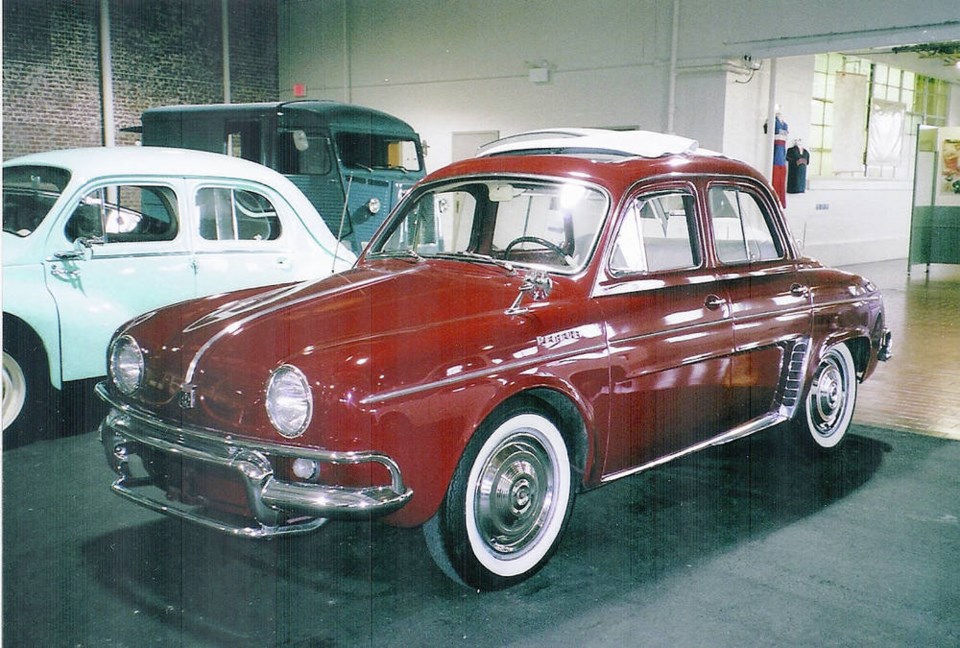One of the most attractive small sedans imported into Canada and the United States in the 1950s and ’60s was the French Renault Dauphine. North Americans were already familiar with the Renault name from the miniature, rear-engined 4CV “Regie” sedan, although it was too small to be very popular over here.
The Dauphine was introduced in 1956 and as the Volkswagen Beetle was then the best selling imported car, the two were inevitably compared.
Like the 4CV and the VW, the Dauphine’s engine sat longitudinally behind the rear axle. But while the Volkswagen’s engine was an air-cooled, overhead valve flat four, the Renault’s was a water-cooled, overhead valve inline four. Engine cooling air entered through air grilles ahead of the Dauphine’s rear fenders and was routed to the radiator mounted in front of the engine.
Except for an engine enlarged from 750 to 845 cc (45 cu in. to 51.5), the Dauphine’s running gear was similar to the 4CV’s. Power reached the rear wheels through a three-speed manual transmission operated by a rather rubbery feeling floor-mounted shift lever.
Four adults could be accommodated in the Dauphine, although front passengers found the wheel wells encroaching on foot and leg room. Rear knee room was a little marginal due to the short wheelbase.
The Dauphine was an appealing little package, elegantly styled and offering the four-door convenience that the Beetle didn’t. And it offered several other things the VW didn’t.
With a wheelbase of only 2,271 mm (89.4 in.), 129 mm (5.1 in.) shorter than the Beetle’s, and in spite of weighing only 649 kg (1,430 lb) compared with the VW’s 744 (1,640), the Dauphine’s four-wheel independent coil spring suspension provided a smoother ride. Like the VW it had rear swing axles, although the Beetle used torsion bars.
Its water-cooled engine was also quieter and the Renault’s more effective heater was the envy of VW drivers. While still not a furnace, it was better than the Beetle’s which used the engine fan to blow heated engine-cooling air into the cabin.
The performance was close with the smaller engine in the Renault being offset by its lower weight and the engine’s higher specific power output. The Renault’s 32 horsepower was close to the VW’s 36 with an engine only two-thirds as large.
Road & Track (8/56) recorded a zero to 97 km/h (60 mph) time of 30.8 seconds for the Dauphine, and a top speed average of 116 km/h (72 mph). The respective figures for the Volkswagen were 28 seconds and 113 km/h (70 mph) (R & T 10/56). The VW was a little quicker in acceleration while the Renault was slightly faster at the top end.
Although performance for the Renault and VW was comparable that was only part of the story. The Renault really cried out for a fourth gear. With its overdrive four speed transmission the VW was subjected to much lower engine revolutions and wear.
The Volkswagen’s autobahn-inspired overdrive meant that in fourth gear the engine was revving only 2,910 rpm at 97 km/h (60 mph) while the stressed little Dauphine’s was spinning 3,960, more than a thousand rpm higher.
Thus the VW could easily cruise all day at its top speed (at 3,400 rpm). Indeed the VW owner’s manual stated that top speed and cruising speed were the same. The Renault would be screaming along at almost 4,800 rpm at its top speed, a common affliction of small cars at that time.
This overdrive ratio was the factor that set Volkswagens apart from most other small cars of the era, and a major reason for its great success in the wide open spaces of North America.
A sprightlier Dauphine Gordini model arrived in 1962 with performance increased by Italian engine specialist Amedeo Gordini. Tuning the 845 cc engine to produce 40 horsepower compared with the regular Dauphine’s 32 provided a welcome improvement. Zero to 97 km/h (60 mph) was lowered 8.5 seconds to 22.3 seconds while top speed rose 12 km/h (8 mph) to 128 km/h (80 mph).
To be more appealing to North American drivers the regular 1964 Dauphine’s three-speed manual transmission was augmented by an automatic version that shifted electro-mechanically. The 40-horsepower Gordini got a four-speed manual, and although Renault chose to keep the overall ratio virtually unchanged, better interim ratio spacing was provided.
The Dauphine continued until 1968, by which time it had been joined by such models as the Renault R-8 which was roomier and had more modern engineering but was not as stylish.
In spite of its many good points the Dauphine never gained anything like the world wide popularity of the Volkswagen Beetle. But it was an attractive little car that offered the convenience of four doors and luxury of a better heater.


